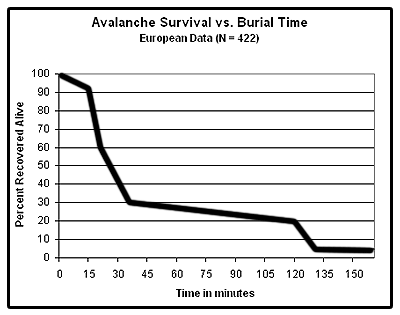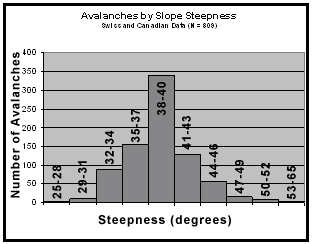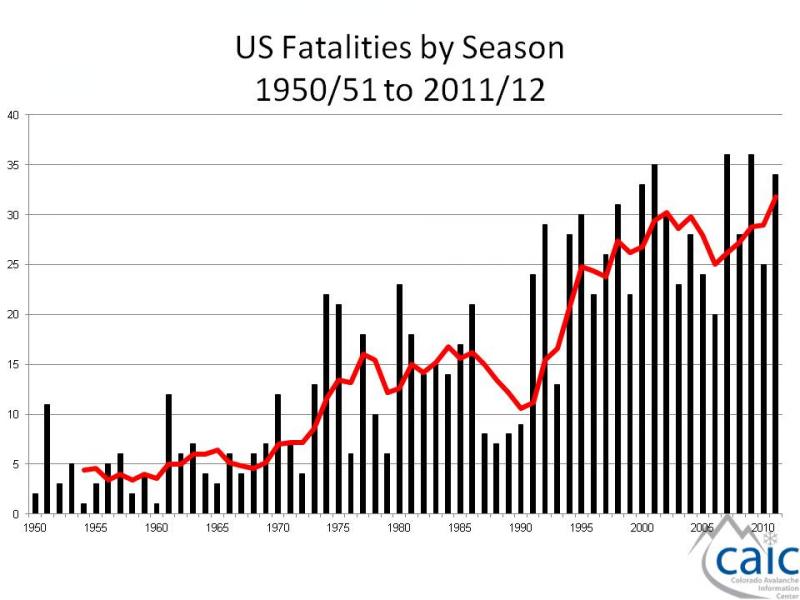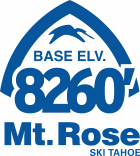
FAQ
Avalanche Myths
| "Loud noises trigger avalanches" |
| Although it's a convenient plot device in the movies (and most recently on Jeep commercials) noise does NOT trigger avalanches. It's just one of those myths that refuses to die. Noise is simply not enough force unless it's EXTREMELY loud noise such as an explosive going off at close range. Even sonic booms or low flying helicopter trigger avalanches only in extremely unstable conditions in which natural avalanches would likely occur on their own anyway. In 90 percent of avalanche fatalities, the avalanche is triggered by the weight of the victim, or someone in the victim's party. |
| "An Avalanche is a bunch of loose snow sliding down the mountain" |
| Avalanche professionals call these "sluffs." Loose snow avalanches account for only a very small percentage of deaths and property damage. What we normally call avalanches are "slabs" or cohesive plates of snow that shatter like a pane of glass and slide as a unit off the mountainside. Picture a magazine sliding off the table, with the victim standing on the middle of the magazine. This is why avalanches are so deadly. |
| Avalanches "strike without warning" |
| We often hear the word "strike" used in the popular media. Stock market crashes, meteor impacts and lost love may strike without warning, but avalanches almost always have obvious signs. Second, avalanches don't "strike". They happen at particular times and in particular places for particular reasons. To repeat again because it's so important: In 90 percent of all avalanche accidents, the avalanche is triggered by the victim, or someone in the victim's party. Natural avalanches occur because new or windblown snow overloads weak-layers or because of rapid warming, but there's almost always obvious signs of instability by the time avalanches come down on their own. |
| "If you see an avalanche coming, get out of the way" |
| Well, at least you can try. An average-sized dry avalanche travels around 80 mph and it's nearly impossible for someone to outrun an avalanche or even have time to get out of the way. A fast snowmobile has some chance but everyone else has a slim chance at best. Also, avalanches that descend from above kill very few people. Do I sound like a broken record here; the vast majority of avalanche incidents are triggered by the victim or someone in the victim's party. |
| "All the avalanche experts are dead" |
| We're happy to report just the opposite. Skilled avalanche professionals enjoy a very low avalanche fatality rate compared to other groups. Less than one percent of all avalanche fatalities involve avalanche professionals. |
| "Spit to see which way is up" |
| It doesn't matter which way is up. You can't dig yourself out of avalanche debris. It's like you are buried in concrete. Your friends must dig you out. |
Frequently Asked Questions
| How fast do avalanches go? |
| Dry slab avalanches typically travel 60-80 miles per hour. They reach these speeds within about 5 seconds after they fracture. Wet avalanches usually travel much slower, around 20 miles per hour. |
| What kind of avalanche is most dangerous? |
| Dry slab avalanches account for almost all avalanche fatalities. A slab avalanche is like a dinner plate sliding off the table. A cohesive plate of snow slides as a unit on top of weaker snow. The slab shatters like a pane of glass with the victim in the middle of the slab and usually there's no escape. |
| What causes slab avalanches to fracture? |
| Snow is a lot like people. It doesn't like rapid change. (Raise taxes slowly enough and no one notices.) Dry slab avalanches occur when the weak layer beneath the slab fractures, usually because too much additional weight has been added too quickly, which overloads the buried weak layer. Snow is very sensitive to the rate at which it is loaded or stressed. Two feet of snow added over two weeks is not a problem. Two feet of snow in two days is a much bigger problem. Two feet of snow in two hours is a huge problem. (Wind can easily deposit two feet of snow in two hours.) Then, finally the weight of a person can add a tremendous stress to a buried weak layer, not in two hours, but in two tenths of a second-a very rapid change. That is why in 90 percent of avalanche accidents, the avalanche is triggered by the victim (or someone in the victim's party). Wet slab avalanches occur for the opposite reason. Percolating water dissolves the bonds between the snow grains, which decrease the strength of the buried weak layer. |
| What kind of weather produces avalanches? |
| Wind is the most common cause of avalanches. Wind can deposit snow 10 times faster than snow falling from storms. Wind erodes snow from the upwind side of obstacles and deposits snow on the downwind (lee sides). We call this "wind loading". The added weight from snowstorms also causes avalanches. If the weight of new snow is added faster than the buried weak-layer can adjust to its load, then it fractures and forms an avalanche. Rapid warming can also cause dry avalanches but this is much more rare. Rain or melting of snow surface can also cause avalanches. For instance, rain on new snow almost instantly causes avalanches. Strong sun or warm temperatures can also cause melting of the snow and creates wet avalanches. Wet avalanches occur because of a decrease in strength of the buried weak layer because water dissolves the bonds between the snow grains. But wind, snow or rapid warming do not always produce avalanches. It depends on the condition of the pre-existing snow and the conditions during the storm. With very stable snow pre-existing snow, even heavy, new snow with wind can bond well and be perfectly safe in the right conditions. Stability analysis is a complicated process and it requires much study and experience to develop good stability analysis skills. |
| Who gets caught in avalanches? |
| Avalanche victims are almost exclusively backcountry recreationists--snowmobilers, climbers, snowboarders, snowshoers, skiers and hikers. Snowmobilers lead the list with twice the number of fatalities as any other activity.
|
| How do people get caught in avalanches? |
| In 90 percent of avalanche incidents, the VICTIM or someone in the victim's party triggers the avalanche. |
| How do people die when buried in avalanche debris? |
The good news is that even dense avalanche debris is about 60-70 percent air, but that's not the problem. People die because their carbon dioxide builds up in the snow around their mouth and they quickly die from carbon dioxide poisoning. Statistics show that 93 percent of avalanche victims can be recovered alive if they are dug out within the first 15 minutes, but then the numbers drop catastrophically. After 45 minutes, only 20-30 percent are still alive and after two hours almost no one is alive. In other words, you don't have much time.
 |
| What do I do if I get caught in an avalanche? |
You're first job is to GET OFF THE SLAB, which as you might imagine, is not very easy.Skiers and boarders technique:If you're descending on skis or snowboard, try heading straight down hill to build up some speed, then angle off to the side off the moving slab. If you're close enough to the crown, you can try running uphill to get off the slab, or running off to the side. If you're ascending when the avalanche breaks, there's really not much you can do. Snowmobilers technique:If you're on a snowmobile you have the advantage of power. Grab some throttle and use your power and momentum to your advantage. If you're headed uphill, continue uphill. If you're headed across the slope, continue to the side to safe snow. If you're headed downhill, you're only hope is to try and outrun the avalanche. Remember that large avalanches travel 60-80 mph and they are difficult to outrun. Also remember that a disproportionate number of avalanche fatalities occur when one snowmobiler gets stuck on a slope and another person rides up to help them. Never go up to help a stuck buddy unless there are several other people in a safe place who can dig you out. This, of course, requires that everyone is wearing beacons and shovels and has practiced regularly with them.
|
| How do I judge the danger of avalanche terrain? |
|

|
| How do I judge snow stability? |
Look for obvious clues:
|
| If you see your friend get caught in an avalanche....? |
|

















